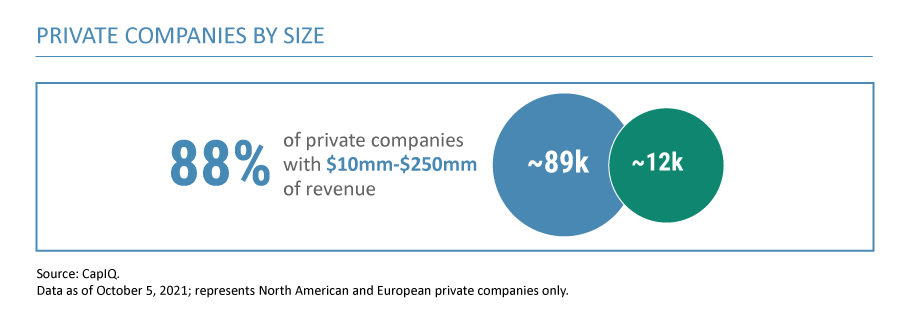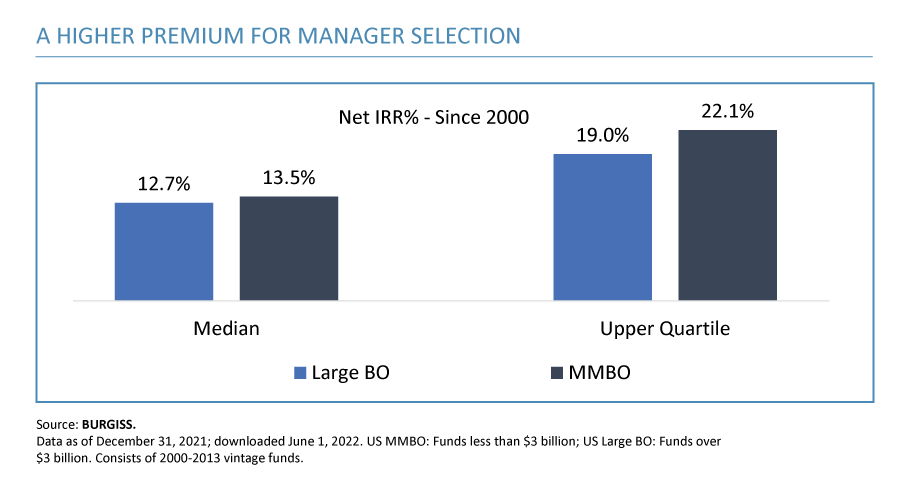Private equity investing: why an increasingly volatile market environment can favour middle market co-investments
Select risks include: information risk, management risk, risks related to reliance on third parties, and risks related to the sale of investments.
A new macro era
Aside from a brief shock in the early months of COVID-19, private markets have generally enjoyed favorable conditions, both for M&A and company operations, over the past few years. Historically low-interest rates combined with manageable inflation and steady growth encouraged active dealmaking and significant capital deployment during this period of time. Companies and sponsors could count on the ample availability of low-cost debt financing and a backdrop that supported top-line growth. These macro-dynamics increased valuations for the largest and highest-quality companies.
However, the macroeconomic outlook has shifted materially since late 2021 from a combination of higher inflation, rising interest rates, and elevated volatility. During periods of increased economic uncertainty, we believe private equity investing in the middle market can be an attractive option for investors looking to create value through operational and strategic enhancements, as compared to investments in larger companies that rely more heavily on a stable and expanding economic environment to drive their performance. By co-investing in middle-market companies alongside high-quality private equity sponsors, investors can benefit from structural inefficiencies that are less dependent on macro factors and do so with more efficient economics.
The opportunity
Amid the current volatile market conditions, we think the case for co-investing in middle-market companies is even more compelling. The opportunity lies in exploiting inefficiencies both in the private markets’ sale process and those often found in the operation of middle-market businesses. We believe middle-market investing presents more controllable and actionable value creation levers for investors, as opposed to larger deals where existing operational processes and efficiencies can limit improvement opportunities. Due to company size, value creation levers implemented in middle-market companies can have a meaningful impact on EBITDA growth, ultimately driving potential returns.
We believe there is an opportunity for investors to take advantage of middle-market inefficiencies across several dimensions:
1. The Opportunity from Sourcing and Diligence Inefficiencies
In North America and Europe, there are approximately 100,000 private companies. Of those 100,00 companies, approximately 89,000 fall in the middle market, leaving investors with an abundance of potential investment opportunities and information to evaluate. Finding attractive investments relies on quickly and effectively assessing a sea of potential opportunities to find the ones that offer the right mix of value and potential. Sourcing is also less efficient in the middle market; some companies may not be working with an M&A advisor, which makes direct sourcing a more difficult but potentially more valuable activity in terms of investment returns.

The diligence process itself is also less uniform than for larger companies. Middle market companies frequently have information gaps when they begin to look for an institutional partner. Financial and operational information may be less structured and more difficult to access than with larger companies. To find solid investments in the middle market, investors must be prepared to evaluate information in whatever form it’s available.
Finally, the “right” opportunity doesn’t just depend on the target company, but also how it matches with the resources and expertise of the sponsor, what we call the “sponsor fit” of the deal. A key driver of the secular value expansion in middle-market companies is from the strategic and operational changes they make in partnership with the sponsor. “Sponsor fit” is consequently a key element of the investment approach. Ultimately, capturing the opportunity in these inefficiencies can generate outsized returns to experienced middle-market investors that are not tied exclusively to the macro-dynamics of the market environment.
2. The Opportunity from Management and Operational Inefficiencies
There can be many levers to materially impact the operations or performance of a middle-market company. This phase of maturity can unlock significant value and drive scaled growth, as businesses transition from the typically less-efficient practices and norms of small operations to the more standardized, efficient norms of larger organizations. For instance, investing in middle-market businesses can present opportunities to:
- Augment or replace the management team.
Private equity investors have access to broad networks of business leaders who can increase the capabilities of middle-market companies. Sponsors can drive value at these businesses by adding seasoned executives with deep industry experience to the management team or by creating new roles to lead growth initiatives. Strategic human capital investments can accelerate the growth of middle-market companies and make these organizations more competitive over time.

- Upgrade benchmarking data and strategic planning.
Middle market companies tend to focus most of their resources on maximizing day-to-day operations, which is how they achieved the growth to reach middle market size, but they may be under-invested in terms of some of the benchmarking and strategic tools that larger companies have accessed for years. Some lack standardized KPIs or the data infrastructure to track their performance and profitability across their regions or lines of business, or to assess their strategy against peers. Sponsors can bring in this kind of toolkit, giving managers more information to run their businesses. In contrast, companies of scale or that have been through several years of private equity ownership have likely already captured the sizeable benefits of this kind of toolkit upgrade.
- Create value through M&A.
Middle market companies may not have explored M&A in the past, as smaller companies rarely have the tools or capital to pursue a proactive acquisition strategy. In fact, this kind of inorganic growth strategy can be quite impactful as smaller bolt-on acquisitions can be purchased at accretive multiples and can generate considerable synergies.
- Better access to and utilization of capital.
Many companies in the middle market space are still using local banking relationships with limited options for sourcing capital. By partnering with a private equity firm, they gain new access to larger and more sophisticated capital relationships, enabling them to tap into debt and equity funding through banks, fund partners, and capital markets.
3. The Opportunity From Exit Options
When a middle-market firm goes through its first era of private equity ownership, it may be moving from a small entrepreneurial organization to a significantly larger, more sophisticated platform. This phase of growth often commands a “re-rating” of their valuation multiple, which reflects the scaling of the business. The same re-rating boost does not usually apply for companies that are going from large to larger.
At the end of the investment holding period, middle-market companies are also greeted with a range of potential exit options. They can pursue a sale to a strategic buyer, a financial buyer, or in some cases an IPO. The value-creation process can make a small company more marketable in general, yet the company is still at an investable size for a significant pool of buyers. In contrast, mega-caps are feasible investments for a more limited universe of potential buyers. Most importantly, these mid-sized companies are not as dependent on the IPO window and broader public market activity in order to be sold and generate liquidity.
4. The Opportunity to Outperform
Investing in middle-market buyouts provides the opportunity to generate higher returns than investing in the larger end of the market. Furthermore, partnering in deals alongside the top-performing managers can lead to increased outperformance. A meaningful performance gap exists between upper quartile buyout funds focused on middle-market companies and those focused on large buyouts. As seen below, upper quartile middle-market buyout funds generated a 22.1% net IRR compared to 19.0% for upper quartile large buyout funds. That’s 310bps of incremental net IRR for top-performing middle-market funds. Ultimately, this gap suggests that investing in middle-market companies can lead to outperformance versus larger companies and that incremental performance significantly increases when you partner with the right managers.

The infrastructure needed to access middle market potential
With a more volatile backdrop for operations and capital markets, there’s a case for focusing on investments that have more structural inefficiencies and controllable operational levers to create value. Middle market companies can be at an appealing point in their growth trajectory, ready to upgrade operations, expand management teams, and/or pursue accretive acquisitions.
However, this market is only accessible to those with the right infrastructure in place. That includes a large network of sponsor relationships with whom to co-invest as well as the resources and experience to help investors assess opportunities in a market with less visibility. We believe the ability to successfully capitalize on middle-market co-investments is especially powerful for navigating the current market environment.
Never miss an insight
Enjoy this wire? Hit the ‘like’ button to let us know. Stay up to date with content like this by hitting the ‘follow’ button below and you’ll be notified every time we post a wire.
4 topics
1 stock mentioned

